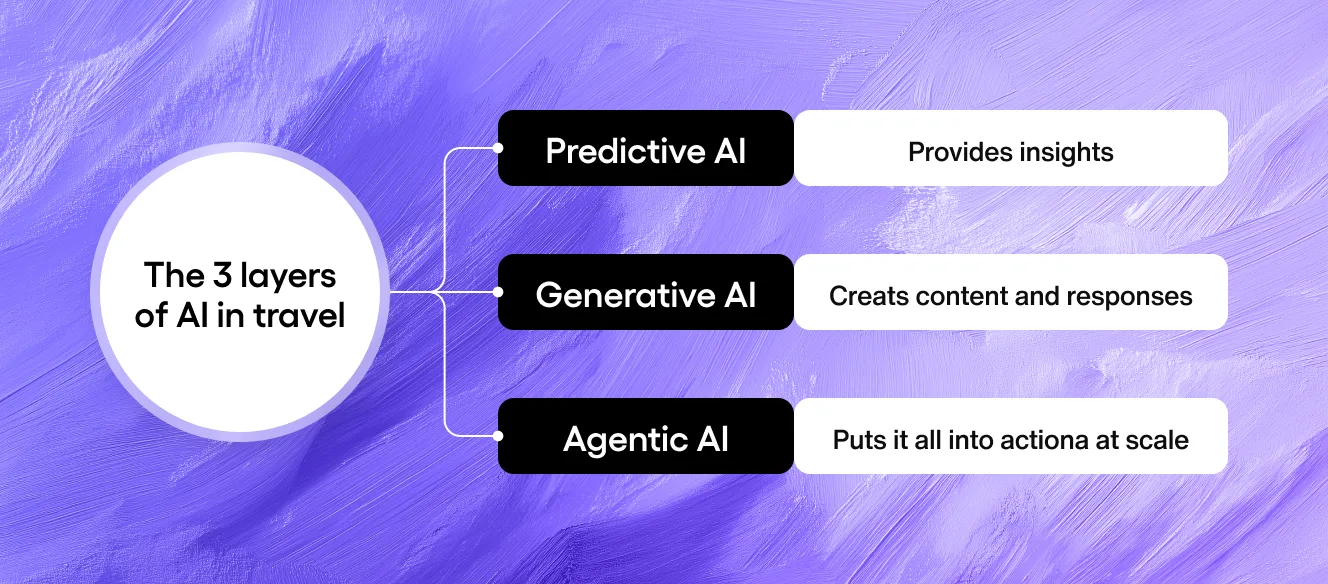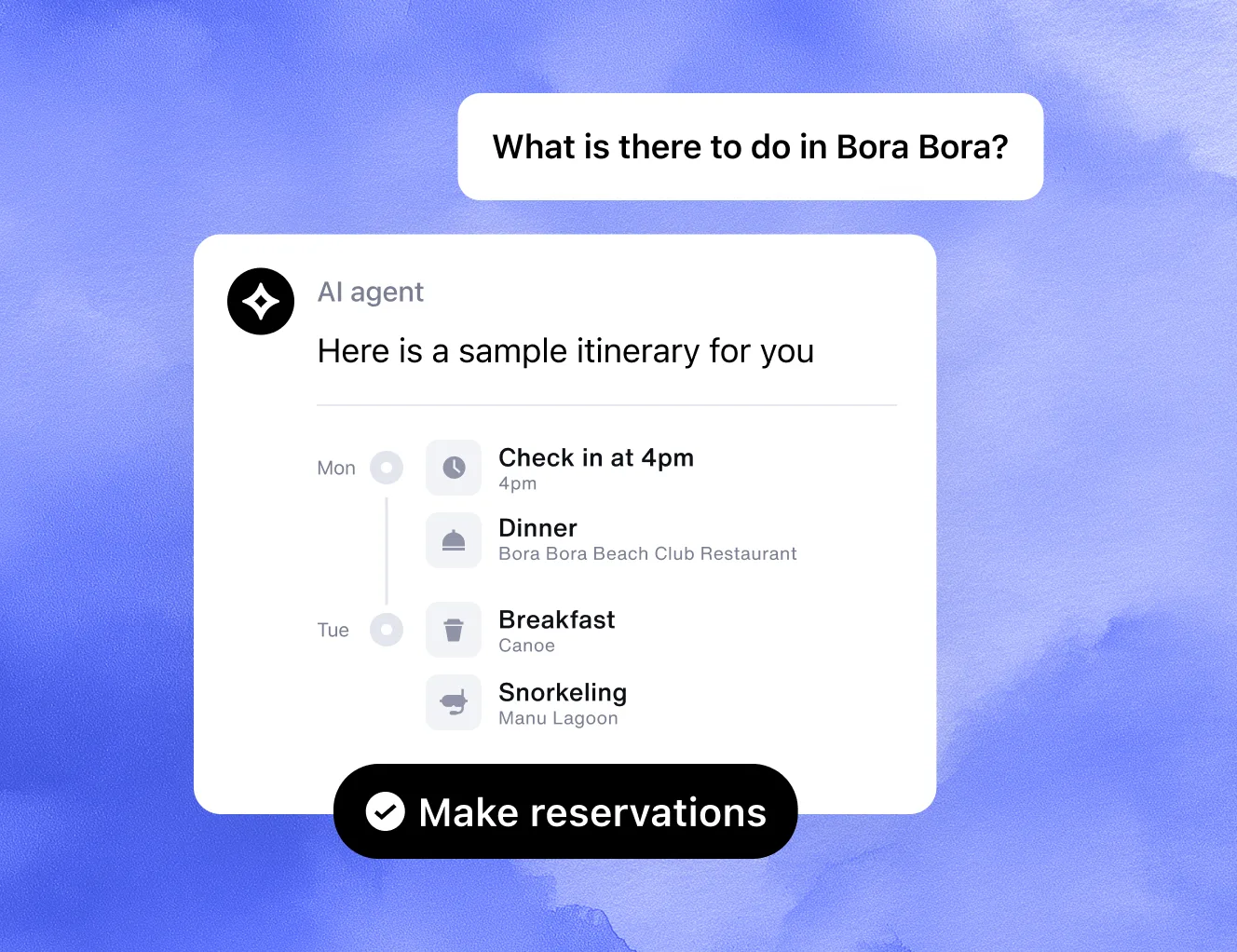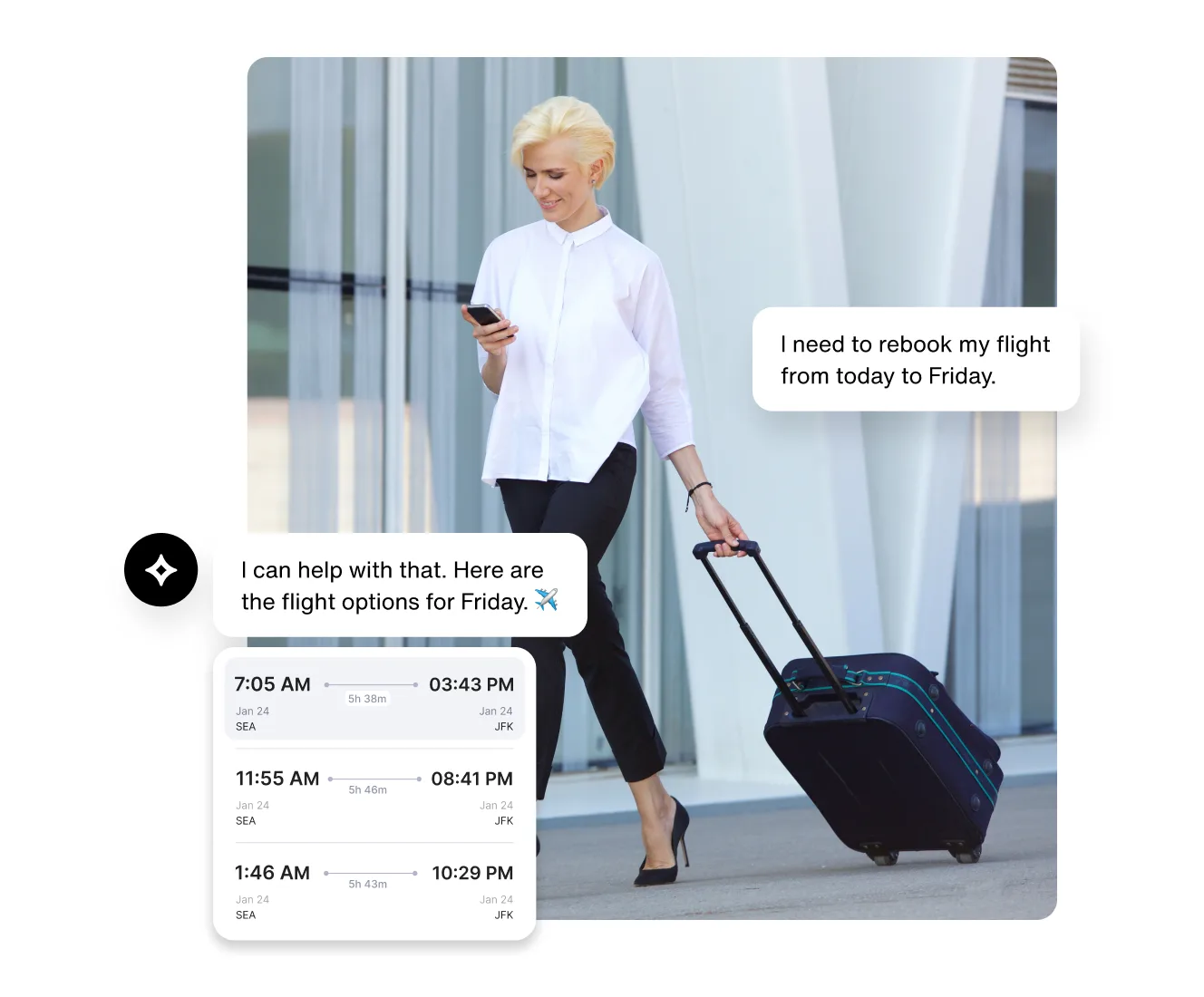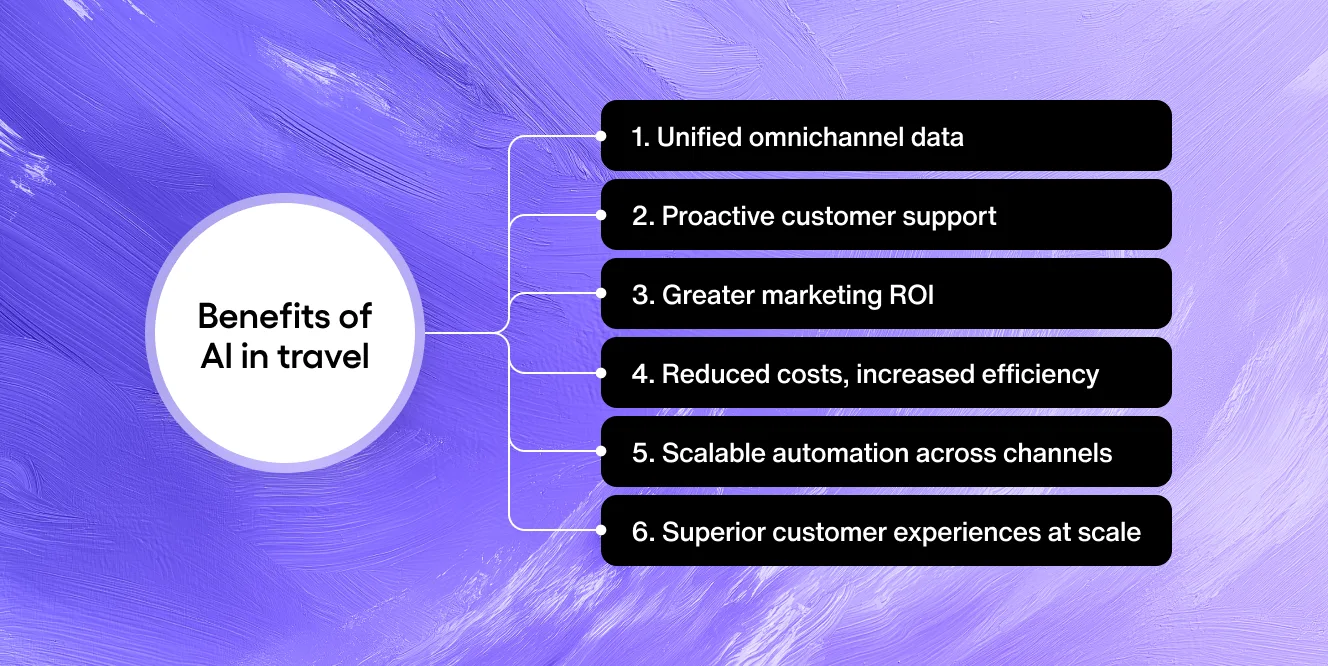6 disruptive AI in travel use cases and advantages in 2025 (+AI strategy)

Imagine a world where you can automatically detect travel disruptions, process cancellations, and instantly rebook customers—replacing frustration with delight—while operations become more efficient and data-driven. This is the transformative power of AI in travel.
From predictive analytics to generative AI chatbots, AI is fast becoming the new engine of the travel industry. According to McKinsey's 2025 survey, Remapping travel with agentic AI, funding for AI travel startups spiked from 10% to 45% since 2023. Also, most companies using AI reported over 6% annual revenue growth and cost savings, signalling AI's growing role in competitive operations. AI concierges are the next frontier—autonomous systems that use real-time data and execute tasks end-to-end—signaling a shift from reactive to proactive, intelligent automation.
In short, AI is redefining both the traveler experience and business operations—cutting costs, increasing productivity, and enabling a new standard in personalized customer experience (CX) that leads to greater loyalty and growth.
Read on to learn about 6 key AI use cases in travel, their benefits and challenges for the travel industry, and a strategic framework to guide effective AI (artificial intelligence) adoption in the future.

Read the full report + in-depth CX case studies
Understanding AI in travel: From intelligence to action
From operations to CX to logistics, AI is transforming how travel works. By analyzing data from booking systems, flights, weather, and customer behavior in real time, AI enables travel companies to anticipate disruptions, streamline operations, and improve decision-making—all while delivering a more personalized traveler experience at scale.
While AI isn’t new in travel per se, its role has evolved beyond rule-based automation and reactive chatbots. Today, AI agents for travel can operate across formerly siloed platforms, using live data and context signals dynamically, and even collaborating with other agents to perform complex tasks end-to-end. The result is a new level of autonomy, adaptability, and resilience in business systems that helps address the most persistent challenges of the travel sector.
For airlines, hotels, and travel platforms, AI is both an analyst and an integrator—unifying fragmented data and putting it to work intelligently to improve efficiency, optimize revenue, and elevate service quality. For travelers, AI serves as a 24/7 digital concierge—providing instant support across channels, tailoring recommendations, and predicting the best time to book flights or hotels.
According to a 2025 Statista report, 40% of global consumers already use AI for travel planning. Another report reveals 78% say AI improves trip planning, a clear sign of its growing role in customer travel journeys.
To remain competitive, travel companies must embrace the new AI stack. It’s not about a single AI tool, but an ecosystem of technologies that are complementary when implemented correctly. These include:
Core types of AI in travel
Predictive AI
Uses machine learning (ML) to analyze historical and real-time data (e.g., booking patterns, behavior, demand trends) to identify patterns and forecast outcomes.
Use cases: Demand forecasting, dynamic pricing, predictive maintenance, route and logistics optimization, marketing segmentation.
Generative AI
Uses natural language processing (NLP) to understand and produce tailored, contextually relevant responses to users in real time in any language.
Use cases: AI-powered travel assistant (chatbots), smart itinerary creation, marketing content production, personalization strategies, automated multilingual customer communications and support.
Agentic AI
AI agents are intelligent systems that can perceive, reason, make decisions, and act autonomously in real time to achieve defined goals. Capable of operating across systems and accessing external data, they can monitor situations, understand how and when to intervene, then take multi-step actions without human intervention.
Use cases: Automated customer communications, deep personalization, proactive disruption management, itinerary planning/booking, and cross-platform coordination between airlines, hotels, and travel partners.
In short, predictive AI is for anticipating, generative AI is for responding, and agentic AI is for putting it all into action at scale across channels. By integrating AI, travel companies can move to more flexible, proactive, and profitable operations that deliver a more convenient, seamless experience to customers at scale.


Read the full report + in-depth CX case studies
The 6 most disruptive AI use cases in travel in 2025
AI is redefining how people plan, book, and experience travel—and how companies meet them there. Below are some of the most impactful AI use cases in travel.
1. Personalized AI travel planning and booking
One of the most exciting examples of AI in travel is the rise of smart itinerary generation. Travelers can describe their needs and budget, and the generative AI-driven system will analyze their preferences, behavior, and even contextual data like local weather to create a tailored itinerary complete with destinations, hotels, and activities—no manual searching required
For example, a traveler might ask ChatGPT or an AI agent for travel on a travel website: “What should I do in Bora Bora next month?” Instead of returning a list of links, the AI travel assistant interprets the user intent, researches, and returns a bespoke curated itinerary. It can then book the selected flights and accommodations via connected service provider APIs—saving time and enhancing the traveler experience by acting as a personal digital travel agent.

As customers increasingly turn to AI-driven travel discovery and booking—also known as agentic commerce—businesses must prepare for a decline in direct traffic. Rather than relying solely on traditional SEO and ad channels, AI search optimization will be vital to remaining visible and competitive in the AI-driven future.
2. Hyper-personalization at scale
AI is enhancing personalization in travel by tailoring experiences based not only on historical customer data, but also real-time context and behavioral signals. By accessing CRMs, booking platforms, and external data sources in real time, AI agents can analyze a traveler’s purchases, preferences, and intent—along with live session context—to deliver more timely, relevant experiences that improve engagement, conversion, and loyalty.
For example, a travel app might suggest a restaurant near the traveler’s hotel that matches purchases made on third-party platforms, or an activity that fills a gap in their itinerary, or a last-minute offer for a seat upgrade. This shift from static to dynamic, context-aware personalization is driving interest, with 52% of hospitality and travel marketers saying they plan to invest in AI-driven personalization by the end of 2025.
3. Marketing
Travel companies can use AI to dynamically personalize marketing in real time with greater precision. By analyzing the intent and in-session behavior of travelers along with historical data, businesses can reach the right audience at the right time to increase marketing ROI.
This can involve techniques like dynamic segmentation and targeting, where AI groups customers by behavior like trip purpose or loyalty tier to trigger the most appropriate offers (free checked bags for budget travelers, lounge access for premium customers). Or, generative content creation, where AI generates personalized marketing assets (landing page copy, emails, promotions) for each segment. Or, according to a 2024 Skift survey, 61% of travel marketers said that customer journey mapping was their most important use case.
4. Automated AI customer service
AI has revolutionized customer service in travel. The most common example is AI chatbots, which provide 24/7 assistance for bookings, flight updates, and itinerary changes. Embedded on websites, mobile apps, and messaging channels, they free human teams from repetitive tasks to streamline operations and reduce costs—while making smart handoffs if needed. Underscoring how integral these tools have become, the global chatbot market is set to reach $15.5 billion by 2028.
The next generation of chatbots is AI agents. Unlike reactive bots that only respond when prompted, AI agents take a more proactive approach. For example, if a flight is canceled, the agent can proactively message the traveler via the app, SMS, or email, offer a selection of rebooking options, and process the transaction on its own—transforming a moment of friction and frustration into one of trust and loyalty.

5. Operations and logistics
AI helps the operations side of the travel industry to anticipate issues, shorten queues, and accelerate disruption recovery. For example, United Airlines uses predictive analytics AI to anticipate flight delays and disruptions by analyzing historical weather patterns and air traffic control data. Custom AI models can also flag airplane components at risk before failure, cutting AOG events and subsequent delays. Airports and TSA pilots use AI-driven facial recognition to speed ID checks and bag drop for consenting passengers to reduce bottlenecks
6. Revenue management
AI is upgrading the revenue management strategies of the travel sector by leveraging real-time customer behavior signals, contextual data, and granular personalization to optimize pricing and profitability. By combining predictive analytics with personalization, AI helps travel brands unlock smarter revenue strategies that respond dynamically to demand, competition, and traveler intent.
This can involve:
Dynamic pricing and inventory management: Airlines and hotels now use machine learning to adjust prices by segment, channel, and micro-demand patterns. These AI models balance revenue goals with traveler willingness to pay across a myriad of factors, improving both yield and customer satisfaction.
Price guidance and predictive offers: Apps like Hopper use predictive and generative AI to analyze billions of price points daily, offering “book,” “hold,” or “wait” recommendations to travelers with up to 95% accuracy. This same approach enables proactive upselling: suggesting add-ons like seat upgrades, priority boarding, or hotel deals at just the right moment to maximize conversion.

8 major support hassles solved with AI agents
Benefits of AI in travel
AI offers travel companies clear advantages over legacy systems, both operationally and experientially. According to McKinsey research, after adopting AI, 26% of travel-related organizations report cost reductions, 30% report faster decision-making, and 59% increased productivity.
Here are some of the most impactful benefits for travel businesses:

1. Unified omnichannel data
Agentic AI can consolidate data from formerly disjointed sources—booking systems, CRMs, customer interactions—into one cohesive data layer. This supports enhanced data analysis, decision making, and omnichannel personalization strategies that have been elusive until now.
2. Proactive customer support
AI customer service can anticipate disruptions and proactively notify travelers of travel alternatives to reduce human workload, recovery time, and secure loyalty in stressful moments.
3. Greater marketing ROI
AI-driven segmentation and recommendation engines can personalize offers based on traveler intent, loyalty status, and trip context to improve conversion rates, campaign performance, and customer loyalty.
4. Reduced costs, increased efficiency
By automating routine tasks and support queries (ticket changes, itinerary management, refund processing), AI frees frontline employees to focus more on empathetic, human-to-human customer interactions.
5. Scalable automation across channels
AI can automate most basic support tickets, manage real-time customer communication across multiple channels, and deliver consistent service globally through multilingual, localized AI agents.
6. Superior customer experiences at scale
AI can proactively deliver tailored support and marketing offers across channels without forgetting customers, helping to reduce friction, resolution times, and secure customer loyalty through the seamless experiences customers say they expect.
“Sendbird’s AI agent has been a game-changer. Our CX team is highly satisfied and more proactive than ever—it’s transforming how we manage customer conversations.”
— Martina Panza, Head of CX, Norse Airways
Core challenges of AI in travel
For all its advantages, AI in travel isn’t without its risks, limitations, and roadblocks to successful implementation. Some of the most common AI challenges include:
1. Lack of AI expertise and talent
According to McKinsey, the most cited challenge of travel executives is a lack of AI expertise and talent. Implementing AI requires extensive employee training and investment in AI-specific roles, both of which can be costly and disrupt operations.
2. Lack of a roadmap for AI transformation
Per McKinsey, the second most cited roadblock to AI adoption among travel executives is the creation of a digital roadmap backed by senior leadership and tied to business outcomes. Without a clear AI strategy, effectively navigating the evolving AI landscape is nigh impossible.
3. Data readiness
The travel industry tends to rely on fragmented data, but AI requires vast amounts of high-quality data to be effective. Without centralized data ownership and management, organizations struggle to train AI models, orchestrate workflows, and tailor experiences at scale.
4. Legacy system integration
Many travel companies still operate on legacy IT systems that weren’t built for AI connectivity. Integrating AI solutions often requires major upgrades, custom agent-ready APIs, and specialized AI expertise to connect old architectures with new, data-driven systems.
5. Data privacy & compliance
AI can traffic in sensitive customer data, making compliance with evolving regulations critical yet difficult. Organizations must ensure transparent data use, secure storage, and consent-based personalization to maintain data privacy, customer trust, and compliance.
6. AI trust and transparency
As AI becomes central to the travel experience, travelers need to understand how and why AI decisions are made, or trust can erode. Building explainable, transparent AI systems helps to prevent bias, ensure accountability, and reinforce customer trust in AI-driven experiences.
7. Maintaining human connection
Many customers prefer human support in high-stress travel moments, so businesses must find a balance between AI automation and human empathy or risk customer fallout (as happened with Klarna).
“With Sendbird, [human] agents receive tickets pre-filled with the key information they need. It saves time and makes every interaction smoother.”
— Niklas Hangeland, Senior Backend Engineer, Norse Airlines
A strategic roadmap for AI adoption in travel
Adopting AI and agentic systems in travel isn’t just a technology upgrade—it’s a business transformation. Here’s a step-by-step roadmap to guide your organization from exploration to execution.
1. Prepare your technology foundations
AI can’t thrive without a strong foundation. Begin by assessing your current infrastructure and data readiness.
Key enablers: Scalable cloud platforms, unified data pipelines, and prior experience with traditional AI tools.
Pro tip: Some organizations are experimenting with AI that improves AI—deploying agentic systems to autonomously maintain or upgrade code, perform QA, and manage infrastructure.
2. Chart a clear digital roadmap
Technology adoption must align with business outcomes. Define where AI adds the most value—whether in customer service, operations, or pricing.
Secure senior leadership sponsorship to ensure alignment across departments.
Focus on full domain transformation, not isolated pilots, to maximize AI's impact.
3. Upskill your workforce
Rather than invest in in-house ML engineers, data scientists, organizations can look for trusted vendors with travel-specific expertise and professional services for their target AI use cases.
Invest in upskilling programs to teach staff how to work with AI-driven tools and dashboards.
Identify “AI champions” across departments to model adoption.
Avoid AI fatigue by focusing on a few high-value tools with clear business impact rather than vague, company-wide mandates.
4. Foster a flexible, innovative culture
Agentic AI evolves fast—and so must your organization.
Encourage experimentation and cross-functional collaboration.
Stay informed on new tools, run regular build-vs-buy assessments, and pivot quickly if something isn’t delivering value.
Reward adaptability and learning, not just efficiency.
5. Redesign business processes end-to-end
According to McKinsey, digital transformations tend to falter in the scaling phases due to outdated workflows. Instead of “bolting on” AI to existing processes:
Map key customer and operational journeys end-to-end.
Redesign processes to embed AI at every relevant touchpoint—booking, disruption management, support, and personalization.
Treat workflow design as an ongoing transformation, not a one-time project.
6. Measure, learn, and scale
Set clear AI success metrics (CX scores, cost reduction, resolution time, ancillary revenue).
Use pilot programs to refine approaches before scaling AI.
Document lessons learned and replicate across markets or brands.
“The [Sendbird] AI agent keeps getting better with our feedback. It already delivers strong results, and we’re excited about the roadmap ahead.”
— Niklas Hangeland, Senior Backend Engineer, Norse Airlines
The future of AI in travel with Sendbird
Looking ahead, AI in travel will evolve from isolated tools to interconnected systems that collaborate across providers, powering adaptive, end-to-end travel automation that revolves around customer preferences and behavior.
Before travel companies can reach this more profitable and efficient future, they need one thing: trust. Travelers need assurance that AI systems are secure, private, and working in their best interest, while organizations must be sure these technologies operate safely, compliantly, and responsibly at scale—or they won’t be worth the investment.
This is where Sendbird Trust OS comes in. Trust OS is Sendbird’s enterprise-grade AI governance framework, designed to power safe, compliant, and transparent AI operations at scale. It provides the observability, governance, and safety travel companies need to deploy AI agents for travel and hospitality with confidence. With trusted global infrastructure at the core, travel companies can focus on what matters most—delivering smarter, more seamless, and more human travel experiences powered by AI.
To learn more, read about why organizations choose Sendbird or contact sales.











